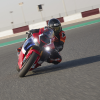
Visordown’s been spending a few weekends with the Kawasaki ZX-6R Ninja. Here’s what it’s like to live with a supersport legend through winter
WITH a lineage that stretches back nearly 25 years, the ZX-6R Ninja is one of the longest running sportsbikes still currently in production. And when you consider the current state of the inline 4-pot sportsbike market, which is currently only inhabited by a handful of bikes, it’s long life and ongoing success make it all the more an impressive machine.
So, a winter review of the ZX-6R Ninja. I have to admit, from the outset it sounds about as much fun as sticking your hand into spinning blender. But as I’ve found out, the little ZX-6R has many strings to its bow. Most of which make it more than just a machine to go hunting apexes on track when it’s sunny.
I think I should also point out, I’m not saying that the Ninja is an ideal motorcycle for hacking through winter or winter tours, the incoming Ninja 1000SX or a Versys would be much more at home. The point of this test was to prove that sportsbikes are not just for summer. With a little bit of planning and some decent kit you can ride this adrenalin injection system all year round.
Is the Kawasaki ZX-6R Ninja comfortable?
Sportsbikes and comfort are not two things that really go together when judging the levels of luxury offered by these no-compromise road racing machines you must be subjective. But with my subjective head on I was mightily surprised by how comfy and roomy the little Kawasaki is.
I’m 5’7” and about 12-stone and find the upper body ergonomics about as good as you can get on a sportsbike. After many hours spent trundling up and down the motorway to various launches on my little green friend, I’m always surprised by how relaxed my upper body is. Almost all sports bikes feel comfy on track or when hammering along a B-road. Just the act of scything from apex to apex on one takes your mind away what discomfort you might feel. But spending two and half hours on the motorway at 4:30am, in -5°C temperatures; still finding the ergonomics of the bike spot on is a pretty neat trick.
The seat of the Ninja is a treat too, it’s not overly padded or soft but is big enough to allow you to shift about should you need to. I like the seat to peg distance as well, never really needing to give my legs a stretch unless I’m in the saddle for more than a couple of hours – and by then you’ll need some fuel any way!
What’s the weather protection like?
Like any sportsbike, the aerodynamically designed fairing is there to help the bike cut through the air with minimal fuss – not to keep the rider dry. That said, if you are able to get yourself into a semi-racing tuck position, it’s only really your shoulders and upper body that get wet. The lithe and low-set screen actually creates a nice little bubble to hide in, while the side fairing panels are just about wide enough to keep your legs out of the worst of the winter weather. Put it this way, the last two launches I’ve done, Triumph Rocket 3 and Kawasaki Z900, involved schlepping along the M40 in freezing temperatures and sideways rain. I was wearing textile jeans a non-waterproof leather jacket and thermal base layers and was surprisingly fine.
If there is one thing I couldn’t do without on the Ninja, it’s some heated gloves! The slimline fairing doesn’t offer much protection for your hands and even winter gloves will succumb to the sub-zero chills after half an hour. Luckily, the battery on the ZX-6R Ninja is within easy reach and feeding the wires up to the headstock and out of danger is a doddle!
Long live traction control!
And multi-level traction control at that! One of the saviours of a bike like this – especially when riding in winter – is well set up and easy to use electronics. Thankfully the Kawasaki has just that and they have saved my ham-fisted backside countless times!
I’m not a complete buffoon on a motorcycle, been doing this a few years now and ridden countless bikes, from 125s to the supercharged Kawasaki H2. But there are times when an early start combined with a late-night working means my head is not 100% in the game – for the first couple of hundred yards anyway. It’s those cold tyres, cold road, sleepy head type days when I’ve been super impressed with KTRC system and the two-level engine power modes.
The KTRC system works away in the background, chipping in when needed to prevent Kawasaki’s lovely little supersport machine from sliding down the A444 on its side every morning. As the road warms and my brain wakes up, it’s quick and easy to crank the electronics down a peg or two for a more spirited ride.
The two-level power mode takes a sizable chunk out of the 130-odd horsepower, softening the throttle map in the process. Stick the bike in Low Power mode with the Traction control on full and it’s a compliant and easy to ride as any maxi scooter.
And ABS!
Working alongside the traction control is the KIBS (Kawasaki Intelligent Braking System) that’s more than just an ABS system. The KIBS links the ABS ECU and engine ECU together, allowing the two to share information. This set up monitors wheel speed (front and rear), brake caliper hydraulic pressure, throttle position, engine speed, clutch actuation and gear position. The ABS system can then accurately work out the ideal front brake pressure that you need.
The main bonus that I can see of the system is that you don’t get those bum clenching moments of ‘Oh shit I’m gonna crash’! As the ABS on some bikes releases all the pressure out of the braking system, sending the lever worryingly back to the handlebar! Not what my sleepy head needs on a freezing cold morning when the rain is travelling sideways! The ABS on the Kawasaki ZX-6R Ninja is smooth and precise, not even upsetting the suspension when it does need to intervene.
Kawasaki ZX-6R Ninja winter verdict
When I picked up the ZX-6R I’d just given back the bonkers 220hp Kawasaki Ninja H2 after testing it through Autumn. I have to admit, the thought of jumping straight onto a head down and bum up sportsbike had me longing for a Z1000 or a Versys. My concern couldn’t have been more misplaced though. In fact, the ZX-6R Ninja has been a very willing, surefooted and enjoyable winter companion.
Sure, there are other bikes out there with more winter riding gizmos you could buy, but they won’t set your hair on fire on a decent road or a trackday like the little Ninja will. They also won’t allow you to filter through winter traffic with the same surgical efficiency that this does. As a winter machine it’s actually pretty bloody good.
If you’re the kind of rider that tucks your sportsbike up over winter, think again. Get some decent heated gloves, cover the thing in corrosion protectant and get out there. Remember; a crappy day on a motorcycle is still better than a good day in the car!
Kawasaki ZX-6R Ninja (2020) specs
Engine type | Liquid-cooled, 4-stroke In-Line Four |
Displacement | 636 cm³ |
Bore x stroke | 67 x 45.1 mm |
Compression ratio | 12.9:1 |
Valve system | DOHC, 16 valves |
Fuel system | Fuel injection: Ø38 mm x 4 with oval sub-throttles |
Ignition | Digital |
Starting System | Electric |
Lubrication | Forced lubrication, wet sump with oil cooler |
Performance & Transmission | |
Maximum power | 95.4 kW {130 PS} 13,500 rpm |
Maximum power with RAM air | 100 kW {136 PS} 13,500 rpm |
Fuel consumption | 5.5 l per 100 km |
CO2 emission | 149 g per km |
Maximum torque | 70.8 N•m {7.2 kgf•m} @ 11,000 rpm |
Transmission | 6-speed |
Final drive | Sealed chain |
Primary Reduction Ratio | 1.900 (76-40) |
Gear Ratios 1st | 2.846 (37-13) |
Gear Ratios 2nd | 2.200 (33-15) |
Gear Ratios 3rd | 1.850 (37-20) |
Gear Ratios 4th | 1.600 (32-20) |
Gear Ratios 5th | 1.421 (27-19) |
Gear Ratios 6th | 1.300 (26-20) |
Clutch | Wet multi-disc, manual |
Brakes & Suspension | |
Brakes front | Dual semi-floating 310 mm (x t5 mm) petal discs. Caliper: dual radial-mount, monobloc, opposed 4-piston |
Brakes rear | Single 220 mm (x t5 mm) petal disc. Caliper: single-bore pin-slide, aluminium piston |
Suspension front | 41 mm inverted fork (SFF-BP) with rebound and compression damping and spring preload adjustability, and top-out springs |
Suspension rear | Bottom-Link Uni Trak, gas-charged shock with piggyback reservoir, compression and rebound damping and spring preload adjustability |
Frame & Dimensions | |
Frame type | Twin spar, cast aluminium |
Trail | 101 mm |
Wheel travel | front 120 mm |
Wheel travel | rear 151 mm |
Tyre front | 120/70ZR17M/C (53W) |
Tyre rear | 180/55ZR17M/C (72W) |
Steering angle | left - right 27° - 27° |
L x W x H | 2,025 x 710 x 1,100 mm |
Wheelbase | 1,400 mm |
Ground clearance | 130 mm |
Fuel capacity | 17 litres |
Seat height | 830 mm |
Curb mass | 196 kg |

